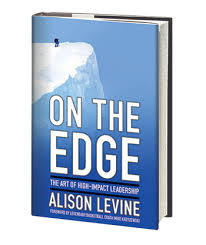Story: In the popular TV show, Undercover Boss, employees believe they are training a job applicant that may be hired, yet they are actually teaching their CEO. "More often than not, the 'undercover boss' can barely perform the tasks she or he is supposed to be learning," according to On The Edge author and mountain climber, Alison Levine.
As they patiently teach the newbie they "share their thoughts on their careers or what they think of the company, and ideas for improving the products or ideas," writes Levine. She adds that this is akin to the leadership style of Facebook CEO, Mark Zuckerberg.
He doesn't spend his days holed up in some decked-out office up on a penthouse floor, disconnected from the rest of his employees... Rather, he strategically positioned his desk right smack in the middle of the common workplace at Facebook... His message: We are all in it together.
Levine compares that to the ousted CEO of Merrill Lynch, John Thain who spent "an inordinate amount of cash on his new office -- $1.2 million... which included a $35,000 toilet."
Lesson: Each featured undercover boss gets multiple wins: A first-hand experience with the pressures and joys of working on the front line, insights for improvements, what it feels like to be taking orders rather than giving them and what if feels like to not be the most able person in the room. The CEO builds a direct, emotional bond with some employees and, when the rest of the employees and show watchers discover the CEO's willingness to be a follower who's humbly learning from others, then recognizing and rewarding the employees from whom he learned. Those connective leaders become role models for such behaviors, and generate greater value and visibility for themselves and their firms.
Keep Messages, Rules and Requests Simple And Brief
Story: "Why do emergency room doctors tend to over-diagnose heart attacks in older and overweight people, and under-diagnose them in women and younger people?" asks The Leap author, Rick Smith. Because the weight, age or sex of the patient spurs doctors to consider "all sorts of tangential assumptions that cloud the reality before the doctors' eyes." Instead, he advises them to first look for no more than the four most common signs of heart attacks, then consider more variables. Research shows that ER doctors are dramatically better in making a successful diagnosis when they do.
Similarly, "The simpler business metrics are, the easier they are to grasp and translate into useful activity," according former Bain & Company director and author of The Ultimate Question, Fred Reichheld. Consequently, Smith notes in his book, rather than using "long involved surveys" to measure customer satisfaction, Reichheld suggests "reducing the metric to a single 'ultimate question', rated on a one-to-ten scale: 'Would you recommend us to a friend?'"
Lesson: This may sound prosaic at first, yet simplicity and brevity can only be accomplished via clarity, willingness to prioritize (including letting go of some goals) and stepping into the shoes of the people you seek to lead, sell to or otherwise sway. As a connective leader distill your core mission of your firm or team to an actionable, relevant goal so others are more likely to understand and remember it, and use it as a useful guide for their decisionmaking. Few people who seek to lead manage to do this.
Become a Stronger Pattern Seeker And Meaning Maker Ariana 4a
Story: From supporting the creation of "'solar libraries' so impoverished students in the Philippines have access to light to launching experiential design-thinking classes for at-risk youth in the Bay Area" projects are getting LinkedIn funding because the company asks its employees to be "our eyes on the ground; as current volunteers and Board Members," writes Ariana Younai. And that's just one of the programs she described as part of their LinkedIn for Good for Employees innovation and transformation grants. See how the company is leveraging its employees' strongest talents and interests as a way to make a meaningful difference in the world and for their firm. Plus the CEO Reid Hoffman cited he report today, thus continuing the outward ripple of news sharing that pulls in more key stakeholders.
Lesson: Identify a "noble shared purpose" with those you lead, or seek to lead, then advocate a way to "co-create value with them for the larger society" suggests From Smart to Wise co-authors Prasad Kaipa and Navi Radjou. In so doing you are more likely to evoke their happier and higher-performing behavior together as they "keep their eyes open for what connects and integrates each other and their larger purpose" the co-authors discovered. "Organizations driven by purpose and values outperformed the market fifteen-to-one and outperformed comparison companies six-to-one, according to Build to Last co-authors, Jim Collins and Jerry Porras.
As a connective leader in this way, you also evoke added benefits, via what I dub "The Halo Reinforcement Effects." As Hoffman vividly summarizes the pro bono work and funding of his firm, he not only burnishes the company brand and extends its positive visibility in ways that boost enduring customer loyalty in the way The Human Brand authors cite, but also reinforce the continuance of admirable behavior in proud LinkedIn employees. Plus, as the team at Huffington Post has discovered, we are especially prone to share good news.
Three more lessons we can learn from connective leaders: Notice how they step in the shoes of those they seek to lead, exude warmth first then competence, and are deeply connected and widely quoted.
This blog previously appeared on Forbes.

